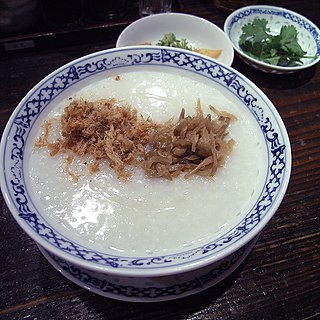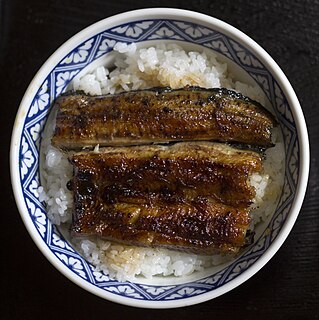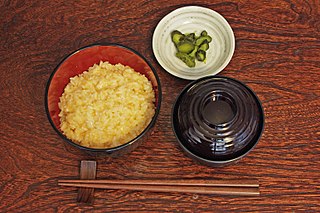 W
WAgemochi (揚げ餅) is a popular Japanese snack food made from fried mochi. The dry mochi is broken into small pieces, about 1 cm cubed, and deep fried. The pieces then puff up. It is usually eaten lightly salted, but also various flavoured versions are made, such as shichimi agemochi, which is agemochi covered with shichimi seasoning. Agemochi can be purchased over most of Japan, and is also a common home-made snack.
 W
WButadon (豚丼), often literally translated into English as pork bowl, is a Japanese dish consisting of a bowl of rice topped with pork simmered in a mildly sweet sauce. It also often includes a sprinkling of green peas. A popular food in Japan, it is commonly served with takuan. Buta means "pig" or "pork", and don is short for donburi, the Japanese word for "bowl". Butadon originated from the city of Obihiro, Japan.
 W
WChahan , also known as Yakimeshi, is a Japanese fried rice dish prepared with rice as a primary ingredient and myriad additional ingredients and seasonings. The dish is typically fried, and can be cooked in a wok. Chahan may have originated in the 1860s from Chinese immigrants arriving at the port of Kobe. Chahan is a staple food in homes in Japan. A variation of the dish is takana chahan. Some restaurants outside Japan serve the dish as a part of their fare.
 W
WChazuke or ochazuke is a simple Japanese dish made by pouring green tea, dashi, or hot water over cooked rice. Chazuke provides a good way to use leftover rice as a quick snack because this dish is easy to make. In Kyoto, ochazuke is known as bubuzuke. Since the 1970s, packaged "instant ochazuke", consisting of freeze-dried toppings and seasonings, has become popular.
 W
WChūkadon (中華丼) is a popular Japanese fast food dish. It consists of a bowl of rice with stir-fried vegetables, onions, mushrooms, and thin slices of meat on top. Literally meaning "Chinese rice bowl", it is inspired by Chinese cuisine. It is a kind of donburi.
 W
WCongee or conjee is a type of rice porridge or gruel eaten in Asian countries. When eaten as plain rice congee, it is most often served with side dishes. When additional ingredients such as meat, fish, and flavourings are added while preparing the congee, it is most often served as a meal on its own, especially for people who are ill. Names for congee are as varied as the style of its preparation. Despite its many variations, it is usually a thick porridge of rice largely disintegrated after prolonged cooking in water.
 W
WDango is a Japanese dumpling made from rice flour mixed with uruchi rice flour and glutinous rice flour. It is different from the method of making mochi, which is made after steaming glutinous rice. Dango is usually finished round shaped, three to five dango are often served on a skewer. Generally, dango comes under the category of wagashi, and is often served with green tea. It is eaten year-round, but the different varieties are traditionally eaten in given seasons.
 W
WDonburi is a Japanese "rice-bowl dish" consisting of fish, meat, vegetables or other ingredients simmered together and served over rice. Donburi meals are usually served in oversized rice bowls which are also called donburi. If one needs to distinguish, the bowl is called donburi-bachi and the food is called donburi-mono .
 W
WGyūdon , also known as gyūmeshi , is a Japanese dish consisting of a bowl of rice topped with beef and onion simmered in a mildly sweet sauce flavored with dashi, soy sauce and mirin. It may sometimes also be served with toppings such as raw or soft poached eggs, Welsh onions (negi), grated cheese or kimchi. A popular food in Japan, it is commonly eaten with beni shōga, shichimi, and a side dish of miso soup.
 W
WHayashi rice or Hashed beef rice is a dish popular in Japan as a Western-style dish or yōshoku. It usually contains beef, onions, and button mushrooms, in a thick demi-glace sauce which often contains red wine and tomato sauce. This sauce is served atop or alongside steamed rice. The sauce is sometimes topped with a drizzle of fresh cream.
 W
WIkameshi is a Japanese dish of rice-filled squid. It is a regional dish from the Oshima area of Hokkaidō.
 W
WJapanese curry is commonly served in three main forms: curry rice , curry udon, and curry bread. It is one of the most popular dishes in Japan. The very common "curry rice" is most often referred to simply as "curry" .
 W
WJapanese rice refers to a number of short-grain cultivars of Japonica rice including ordinary rice (uruchimai) and glutinous rice (mochigome).
 W
WKamameshi literally translates to "kettle rice" and is a traditional Japanese rice dish cooked in an iron pot called a kama. Kamameshi originally referred to rice that was eaten communally from the kama. Coworkers or family members either ate directly from the kama pot or by transferring the rice to individual bowls. The term emerged in the late Meiji period, and is associated with the communal eating of rice in the aftermath of the 1923 Great Kantō earthquake. Later, similar to takikomi gohan, kamameshi came to refer to a type of Japanese pilaf cooked with various types of meat, seafood, and vegetables, and flavored with soy sauce, sake, or mirin. By cooking the rice and various ingredients in an iron pot, the rice gets slightly burned at the bottom which adds a desirable flavor to the rice. Kama designed specifically to prepare kamameshi appeared on the market as the dish became popular across Japan, and the prepared kamameshi is placed directly on the table in its pot for the meal. A small-scale replica of the kama is used to create an individual serving of kamameshi, and the dish is now a popular ekiben.
 W
WKatsudon is a popular Japanese food, a bowl of rice topped with a deep-fried breaded pork cutlet, egg, vegetables, and condiments.
 W
WKatsukarē (カツカレー) is a Japanese dish consisting of a pork cutlet served with a portion of Japanese rice and curry. It is served on a large plate and is typically eaten using a spoon or fork. The cutlet is usually precut into strips, eliminating the need for a knife.
 W
WMochi is a Japanese rice cake made of mochigome, a short-grain japonica glutinous rice, and sometimes other ingredients such as water, sugar, and cornstarch. The rice is pounded into paste and molded into the desired shape. In Japan it is traditionally made in a ceremony called mochitsuki . While eaten year-round, mochi is a traditional food for the Japanese New Year, and is commonly sold and eaten during that time.
 W
WMuchi , also known as onimochi (鬼餅), is a type of soft confectionery made of pounded glutinous rice and eaten in Okinawa Prefecture. Muchi means "rice cake" in the Okinawan language, sometimes called "Casa Muchi" from the fact that it is wrapped in the leaves of shell ginger. After the muchi is seasoned with brown sugar, white sugar, purple yam and so on, it is wrapped and steamed.
 W
WOkowa おこわ (強飯) is a Japanese steamed rice dish made with glutinous rice mixed with meat or vegetables. It is sometimes combined with wild herbs and vessel chestnuts. It is generally boiled glutinous rice blended with Azuki beans to give it red color for festive look, made by boiling regular rice with Azuki beans. Since Okowa is meant to be eaten at room temperature, it is used to make onigiri for its capacity to be frozen well.
 W
WOmurice or omu-rice is an example of yōshoku consisting of an omelette made with fried rice and thin, fried scrambled eggs, usually topped with ketchup. It is a popular dish both commonly cooked at home and often found at western style diners in Japan. Children in particular enjoy omurice. It is often featured in Japan's version of a children's meal, okosama-ranchi (お子様ランチ).
 W
WOnigiri , also known as omusubi (お結び), nigirimeshi (握り飯), or rice ball, is a Japanese food made from white rice formed into triangular or cylindrical shapes and often wrapped in nori. Traditionally, an onigiri is filled with pickled ume (umeboshi), salted salmon, katsuobushi, kombu, tarako, mentaiko, takanazuke or any other salty or sour ingredient as a natural preservative. Most Japanese convenience stores stock their onigiri with various fillings and flavors. There are even specialized shops which only sell onigiri to take out. Due to the popularity of this trend in Japan, onigiri has become a popular staple in Japanese restaurants worldwide.
 W
WOyakodon (親子丼), literally "parent-and-child donburi", is a donburi, or Japanese rice bowl dish, in which chicken, egg, sliced scallion, and other ingredients are all simmered together in a kind of soup that is made with soy sauce and stock, and then served on top of a large bowl of rice. The name of the dish is a poetic reflection of both chicken and egg being used in the dish.
 W
WRed bean rice, called patbap (팥밥) in Korean, sekihan (赤飯) in Japanese, and hóngdòu fàn (红豆饭) in Chinese, is an East Asian rice dish consisting of rice cooked with red beans.
 W
WA rice burger or riceburger is a variation on the traditional hamburger with compressed rice patties substituted for the hamburger buns. The MOS Burger fast-food restaurant chain introduced the rice burger in Japan 1987, and since then it has become a popular food item in East Asia. Beginning around 2005 McDonald's also offered a rice burger in some of its Asian stores, with mixed results. In South Korea they are known as "bapburgers". Popular Korean-style rice burgers include fillings such as Stir-fried kimchi and tuna with mayonnaise.
 W
WA rice cake may be any kind of food item made from rice that has been shaped, condensed, or otherwise combined into a single object. A wide variety of rice cakes exist in many different cultures in which rice is eaten and are particularly prevalent in Asia. Common variations include cakes made with rice flour, those made from ground rice, and those made from whole grains of rice compressed together or combined with some other binding substance.
 W
WScorched rice, also known as crunchy rice, is a thin crust of slightly browned rice at the bottom of the cooking pot. It is produced during the cooking of rice over direct heat from a flame.
 W
WSushi is a traditional Japanese dish of prepared vinegared rice , usually with some sugar and salt, accompanied by a variety of ingredients , such as seafood, often raw, and vegetables. Styles of sushi and its presentation vary widely, but the one key ingredient is "sushi rice", also referred to as shari (しゃり), or sumeshi (酢飯).
 W
WTaco rice is a popular example of post-war Okinawan cuisine. It consists of taco-flavored ground beef served on a bed of rice, frequently served with shredded cheese, shredded lettuce, tomato and salsa.
 W
WTakikomi gohan is a Japanese rice dish seasoned with dashi and soy sauce along with mushrooms, vegetables, meat, or fish. The ingredients of takikomi gohan are cooked with the rice; in a similar preparation, maze gohan (混ぜ御飯), flavorful ingredients are mixed into cooked rice. In the Kansai region, takikomi gohan is called kayaku gohan, and in Okinawa, it is called Jucy. This dish is consumed by people in Japan around the fall season since many root vegetables and mushrooms are harvested during this season in Japan. Ingredients will vary based on the seasonal vegetables and fish. Since this dish contains nutritional value, and uses a small amount of rice with vegetables and proteins, some Japanese people eat it for dieting purposes. One of the reasons why this dish is popular in Japan is because it is easy to make and does not require a lot of equipment to prepare.
 W
WTamago kake gohan is a popular Japanese breakfast food consisting of cooked Japanese rice topped or mixed with raw egg and soy sauce.
 W
WTekkadon (鉄火丼), a type of donburi, is a Japanese rice dish topped with thin-sliced raw tuna sashimi. Spicy tekkadon is made with what can be a mix of spicy ingredients, a spicy orange sauce, or both, usually incorporating spring onions.
 W
WTenmusu, also spelled as ten-musu, is a dish in Japanese cuisine that consists of a rice ball wrapped with nori that is filled with deep-fried tempura shrimp. Tenmusu is sometimes included as a food in bento boxes.
 W
WUnadon is a dish originating in Japan. It consists of a donburi type large bowl filled with steamed white rice, and topped with fillets of eel (unagi) grilled in a style known as kabayaki, similar to teriyaki. The fillets are glazed with a sweetened soy-based sauce, called tare and caramelized, preferably over charcoal fire. The fillets are not flayed, and the grayish skin side is placed faced down. Sufficient tare sauce is poured over so that some of it seeps through the rice underneath. By convention, pulverized dried berries of sanshō are sprinkled on top as seasoning.
 W
WYakimochi is grilled or broiled mochi or pounded rice cake. Traditionally, it is prepared using a small charcoal grill, but in modern times a gas grill can be used. During the time of the Autumn Moon, it is traditional to eat fresh yakimochi while sipping sake and enjoying the view of the full moon.
 W
WZōsui , or ojiya (おじや), is a mild and thin Japanese rice soup akin to a rice-based vegetable soup. It is made from pre-cooked rice and dashi or water seasoned with either soy sauce or miso and cooked with other ingredients such as meat, seafood, mushrooms, and vegetables. It is generally served to those who are sick or otherwise feeling unwell, and is usually only served in the winter.